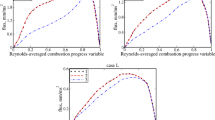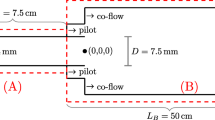Abstract
Incompressible 3-D DNS is performed in non-decaying turbulence with single step chemistry to validate a new analytical expression for turbulent burning velocity. The proposed expression is given as a sum of laminar and turbulent contributions, the latter of which is given as a product of turbulent diffusivity in unburned gas and inverse scale of wrinkling at the leading edge. The bending behavior of U T at higher u′ was successfully reproduced by the proposed expression. It is due to decrease in the inverse scale of wrinkling at the leading edge, which is related with an asymmetric profile of FSD with increasing u′. Good agreement is achieved between the analytical expression and the turbulent burning velocities from DNS throughout the wrinkled, corrugated and thin reaction zone regimes. Results show consistent behavior with most experimental correlations in literature including those by Bradley et al. (Philos Trans R Soc Lond A 338:359–387, 1992), Peters (J Fluid Mech 384:107–132, 1999) and Lipatnikov et al. (Progr Energ Combust Sci 28:1–74, 2002).
Similar content being viewed by others
References
Bradley, D., Lau, A.K.C., Lawes, M.: Flame stretch rate as a determinant of turbulent burning velocity. Philos. Trans. R. Soc. Lond. A 338, 359–387 (1992)
Peters, N.: The turbulent burning velocity for large-scale and small-scale turbulence. J. Fluid Mech. 384, 107–132 (1999). doi:10.1017/S0022112098004212
Lipatnikov, A.N., Chomiak, J.: Turbulent flame speed and thickness:phenomenology, evaluation, and application in multidimensional simulations. Progr. Energ. Combust. Sci. 28, 1–74 (2002). doi:10.1016/S0360-1285(01)00007-7
Zimont, V.L., Mesheriakov, E.A.: A model of combustion of partially premixed gases. In: Structure of Gas Flames. Proceedings of International Colloquium. Part, I.I., Novosivirsk: ITPM SO AN SSSR, pp. 35–43 (1988, in Russian)
Gülder, Ö.L.: Contribution of small scale turbulence to burning velocity of flamelets in the thin reaction zone regime. Proc. Combust. Inst. 31, 1369–1375 (2007). doi:10.1016/j.proci.2006.07.189
Filatyev, S.A., Driscoll, J.F., Carter, C.D., Donbar, J.M.: Measured properties of turbulent premixed flames for model assessment, including burning velocities, stretch rates, and surface densities. Combust. Flame 141, 1–21 (2005). doi:10.1016/j.combustflame.2004.07.010
Cho, P., Law, C.K., Hertzberg, J.R., Cheng, R.K.: Structure and propagation of turbulent premixed flames stabilized in a stagnation flow. Proc. Combust. Inst. 21, 1493–1499 (1988)
Liñán, A., Williams, F.A.: Fundamental Aspects of Combustion. Oxford University Press, New York (1993)
Kolmogorov, A.N., Petrovski, I.G., Piskunov, N.S.: Investigation of the diffusion equation connected with an increasing amount of matter and its application to a biological problem. Bull. MGU A1, 1–26 (1937)
Zeldovich, Y.B., Barenblatt, G.I., Librovich, V.B., Makhviladze, G.M.: The Mathematical Theory of Combustion and Explosion. Consultants Bureau, New York (1985)
Hakberg, B., Gosman, A.D.: Analytical determination of turbulent flame speed from combustion models. Proc. Combust. Inst. 20, 225–232 (1984)
Corvellec, C., Bruel, P., Sabel’Nikov, V.A.: Turbulent premixed flames in the flamelet regime: burning velocity spectral properties in the presence of countergradient diffusion. Combust. Flame 120, 585–588 (2000). doi:10.1016/S0010-2180(99)00120-0
Im, Y.H., Huh, K.Y., Nishiki, S., Hasegawa, T.: Zone conditional assessment of flame-generated turbulence with DNS database of a turbulent premixed flame. Combust. Flame 137, 478–488 (2004). doi:10.1016/j.combustflame.2004.03.006
Lee, E., Im, Y.H., Huh, K.Y.: Zone conditional analysis of a freely propagating one-dimensional turbulent premixed flame. Proc. Combust. Inst. 30, 851–857 (2005). doi:10.1016/j.proci.2004.08.171
Huh, K.Y., Kim, S.H., Kim, S.Y.: Validation of an asymptotic zone conditional expression for turbulent burning velocity against DNS database. In: Proc. of Summer Prog., CTR, Stanford University, pp. 269–282 (2004)
Libby, P.A., Williams, F.A.: Turbulent Reaction Flows. Academic, London (1993)
Sullivan, N.P., Mahalingam, S., Kerr, R.M.: Deterministic forcing of homogeneous, isotropic turbulence. Phys. Fluids 6, 1612–1614 (1994). doi:10.1063/1.868274
Kennedy, C.A., Carpenter, M.H., Lewis, R.M.: Low-storage, explicit Runge–Kutta schemes for the compressible Navier–Stokes equations. Appl. Numer. Math. 35, 177–219 (2000). doi:10.1016/S0168-9274(99)00141-5
Lele, S.K.: Compact finite difference schemes with spectral-like resolution. J. Comput. Phys. 103, 16–42 (1992). doi:10.1016/0021-9991(92)90324-R
Poinsot, T.J., Lele, S.K.: Boundary conditions for direct simulations of compressible viscous flows. J. Comput. Phys. 101, 104–129 (1992). doi:10.1016/0021-9991(92)90046-2
Pope, S.B.: Stochastic lagrangian models for turbulence. Annu. Rev. Fluid Mech. 26, 23–63 (1994). doi:10.1146/annurev.fl.26.010194.000323
Fung, J.C.H., Hunt, J.C.R., Malik, N.A., Perkins, R.J.: Kinematic simulation of homogeneous turbulence by unsteady random fourier modes. J. Fluid Mech. 236, 281–318 (1992). doi:10.1017/S0022112092001423
Plessing, T., Kortschik, C., Peters, N., Mansour, M.S., Cheng, R.K.: Measurements of the turbulent burning velocity and the structure of premixed flames on a lowswirl burner. Proc. Combust. Inst. 28, 359–366 (2000)
Kerstein, A.R.: Pair-exchange model of turbulent premixed flame propagation. Proc. Combust. Inst. 21, 1281–1289 (1988)
Weller, H.G., Uslu, S., Gosman, A.D., Maly, R.R., Herweg, R., Heel, B.: Prediction of combustion in homogeneous-charge spark-ignition engines. In: COMODIA 94. Yokohama: JSME, pp. 163–169 (1994)
Klimov, A.M.: Premixed turbulent flames - interplay of hydrodynamic and chemical phenomena. Prog. Astronaut. Aeronaut. 88, 133 (1983)
Cant, R.S., Pope, S.B., Bray, K.N.C.: Modelling of flamelet surface-to-volume ratio in turbulent premixed combustion. Proc. Combust. Inst. 23, 809–815 (1990)
Author information
Authors and Affiliations
Corresponding author
Additional information
Conference topic: fundamental DNS and LES combustion studies
Type: SI: DNS and LES of reactive flows
Rights and permissions
About this article
Cite this article
Lee, D., Huh, K.Y. Statistically Steady Incompressible DNS to Validate a New Correlation for Turbulent Burning Velocity in Turbulent Premixed Combustion. Flow Turbulence Combust 84, 339–356 (2010). https://doi.org/10.1007/s10494-009-9221-3
Received:
Accepted:
Published:
Issue Date:
DOI: https://doi.org/10.1007/s10494-009-9221-3




